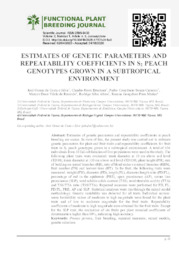Estimates of genetic parameters and repeatability coefficients in S2 peach genotypes grown in a subtropical environment.
Estimates of genetic parameters and repeatability coefficients in S2 peach genotypes grown in a subtropical environment.
Autoria: SILVA, J. O. da C. e; BRUCKNER, C. H.; CARNEIRO, P. C. S.; RESENDE, M. D. V. de; ALVES, R. S.; MATIAS, R. G. P.
Resumo: Estimates of genetic parameters and repeatability coefficients in peach breeding are scarce. In view of this, the present study was carried out to estimate genetic parameters for plant and fruit traits and repeatability coefficients for fruit traits in S2 peach genotypes grown in a subtropical environment. A total of 434 individuals from 55 full-sib families of five populations were used in the study. The following plant traits were evaluated: trunk diameter at 10 cm above soil level (TD10), trunk diameter at 130 cm above soil level (TD130), plant height (PH), rate of budding on mixed branches (RB), rate of blind nodes on mixed branches (RBN), fruit number (FN) and harvest time (HT). In the fruit, the following traits were measured: weight (FW), diameter (FD), length (FL), diameter/length ratio (FD/FL), percentage of red in the epidermis (PRE), apex prominence (AP), suture line prominence (SLP), total soluble solids content (TSS), total titratable acidity (TTA) and TSS/TTA ratio (TSS/TTA). Repeated measures were performed for FD, FL, FD/FL, PRE, AP and SLP. Statistical analyses were run through the mixed model methodology. Genetic variability was detected for all traits. Individual narrowsense heritability values of moderate to high magnitude were found for the plant traits and of low to moderate magnitude for the fruit traits. Repeatability coefficients of moderate to high magnitude were obtained for the fruit traits. Except for the SLP trait, the evaluation of six fruits per plant revealed coefficients of determination higher than 80%, indicating high accuracy.
Ano de publicação: 2020
Tipo de publicação: Artigo de periódico
Unidade: Embrapa Café
Palavras-chave: Fruits, Melhoramento Genético Vegetal, Peaches, Prunus persica var. nucipersica, Pêssego, Selection methods
Observações
1 - Por padrão são exibidas publicações dos últimos 20 anos. Para encontrar publicações mais antigas, configure o filtro ano de publicação, colocando o ano a partir do qual você deseja encontrar publicações. O filtro está na coluna da esquerda na busca acima.
2 - Para ler algumas publicações da Embrapa (apenas as que estão em formato ePub), é necessário ter, no celular ou computador, um desses softwares gratuitos. Sistemas Android: Google Play Livros; IOS: iBooks; Windows e Linux: software Calibre.
Acesse outras publicações
Acesse a Base de Dados da Pesquisa Agropecuária (BDPA) para consultar o acervo completo das bibliotecas da Embrapa.

